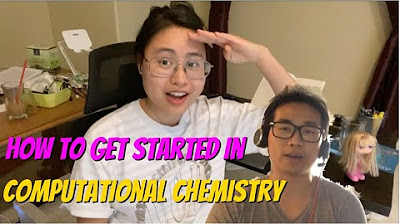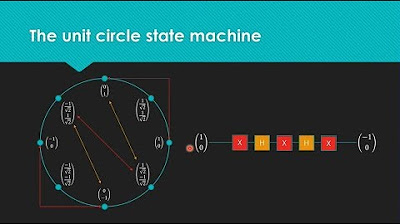what is computational chemistry?!
TLDRThe video script introduces the viewer to the world of computational chemistry, a field that combines computational methods with chemical problem-solving. It breaks down the subject into three main areas: development, simulation/application, and cheminformatics. Development involves creating mathematical models and computational tools like Gaussian and Q-Chem, which are essential for understanding quantum mechanics in chemistry. Simulation/application focuses on using these tools to solve chemical problems, with a strong emphasis on practical application and feedback between computational and experimental chemists. Cheminformatics, while distinct from computational chemistry, deals with analyzing and extracting information from chemical data using machine learning and other computational techniques. The script also touches on the potential of machine learning to revolutionize chemistry by potentially replacing quantum mechanical calculations with more efficient algorithms. The presenter's enthusiasm for the subject is palpable, as they share their personal journey into the field and their vision for the future where computational chemistry becomes accessible to everyone.
Takeaways
- 😃 The speaker has a passion for playing soccer since the age of seven and was inspired to play after attending their brother's game.
- 📚 They have recently started making YouTube videos, partly as a solution to their Google Drive reaching its storage limit.
- 🧪 The speaker is deeply interested in computational chemistry, aiming to explain it in an accessible way to a general audience.
- 🔬 Computational chemistry involves using computational methods to solve chemical problems and is divided into three main areas: development, simulation/application, and cheminformatics.
- 🛠️ Development in computational chemistry is about creating mathematical models and tools like Gaussian, Avogadro, Q-Chem, and ORCA Quantum ESPRESSO.
- 🤔 Quantum mechanics is crucial for understanding chemistry at the atomic and molecular level, which is where the principles of quantum mechanics come into play.
- 🧐 The Schrodinger's equation is central to quantum mechanics and is used to calculate the energy of a system, which is key in computational chemistry.
- 🔍 Simulation/application involves using developed software to solve specific chemical problems, often in collaboration with experimental chemists.
- 📈 Cheminformatics focuses on extracting information from chemical data to expand knowledge, often using machine learning techniques.
- 💊 One application of cheminformatics is in computer-aided drug design, where machine learning can help generate potential drug candidates.
- 💻 There is ongoing debate about whether machine learning can replace traditional quantum mechanical calculations, which are computationally expensive.
- 🌟 The speaker is optimistic about the future of computational chemistry and machine learning, envisioning a time when these techniques are widely accessible and used.
Q & A
What is the speaker's passion since the age of seven?
-The speaker has been passionate about playing soccer since they were seven years old.
How did the speaker get interested in playing soccer?
-The speaker got interested in soccer after attending their brother's game, getting washed and playing, and thinking they could do better.
What motivated the speaker to start making YouTube videos?
-The speaker started making YouTube videos as a solution to their Google Drive maxing out on storage space, essentially using YouTube as free online storage.
What is computational chemistry?
-Computational chemistry involves using computational methods to solve chemical problems, encompassing a broad range of activities from developing mathematical models to simulating chemical reactions and applying cheminformatics techniques.
What are the three main sectors of computational chemistry mentioned in the script?
-The three main sectors of computational chemistry mentioned are development, simulation/ application, and cheminformatics.
Why is quantum mechanics important in chemistry?
-Quantum mechanics is important in chemistry because it governs the physics at the microscopic scale where atoms and bonds exist, which are fundamental aspects of chemical interactions.
What is the role of the Schrodinger's equation in computational chemistry?
-The Schrodinger's equation is used to calculate the energy of a system, such as a molecule, and is central to understanding and predicting the behavior of chemical systems at the quantum level.
What is the significance of Gaussian in the context of computational chemistry?
-Gaussian is a software package used in computational chemistry to optimize the structure of a molecule to its lowest energy state, which is crucial for understanding its stability and reactivity.
How does cheminformatics differ from computational chemistry?
-Cheminformatics involves the application of informatics techniques, including machine learning, to chemical data to predict properties and design new molecules. It is a separate entity from computational chemistry, which focuses more on the computational solution of chemical problems using quantum mechanics principles.
What are some potential applications of cheminformatics?
-Potential applications of cheminformatics include computer-aided drug design, where machine learning can generate libraries of possible drug candidates, and potentially replacing or supplementing quantum mechanical calculations in certain computational chemistry tasks.
How does machine learning in cheminformatics aim to address the computational expense of quantum mechanical calculations?
-Machine learning in cheminformatics can bypass the direct solving of the Schrodinger's equation, providing answers to chemical problems without the need for the computationally expensive quantum mechanical calculations.
What is the speaker's vision for the future of computational chemistry?
-The speaker envisions a future where computational chemistry is accessible to everyone, possibly to the point where individuals can perform computational chemistry in their own homes, much like the widespread use of computers and technology today.
Outlines
😀 Introduction to Personal Interests and Computational Chemistry
The first paragraph introduces the speaker's personal interests, particularly their passion for soccer since the age of seven. It then transitions into the speaker's recent venture into creating YouTube videos, initially motivated by the need for free online storage when their Google Drive reached its capacity limit. The speaker also expresses their enthusiasm for computational chemistry, a field they aim to demystify for viewers who may not have a background in chemistry. The paragraph ends with a humorous touch, suggesting that the prerequisite for watching their videos is to have low expectations.
🧠 Understanding Computational Chemistry and its Subfields
The second paragraph delves into the specifics of computational chemistry, explaining it as the use of computational methods to solve chemical problems. It emphasizes the broad nature of the field and the need to categorize it into more manageable sections. The speaker outlines three main areas: development, simulation/application, and cheminformatics. Development involves creating mathematical models and computational tools, with examples like Gaussian and Q-Chem. Simulation/application focuses on using these tools to solve chemical problems, often in an application-based context. Cheminformatics, while related, is a separate entity that involves managing and extracting knowledge from chemical data. The paragraph also highlights the importance of quantum mechanics in chemistry, particularly at the microscopic level where atoms and bonds are involved.
💻 The Role of Quantum Mechanics, Machine Learning, and the Future of Computational Chemistry
The third paragraph continues the discussion on quantum mechanics, focusing on the Schrödinger's equation, a fundamental concept in the field. It explains the role of quantum mechanics in chemistry and how computational chemistry often relies on approximations due to the complexity of solving the Schrödinger's equation exactly. The speaker then transitions into the application of computational chemistry tools in research and the feedback loop between computational and synthetic chemists. The paragraph also introduces cheminformatics, which involves representing molecular structures and applying machine learning to predict properties and solve problems, such as in computer-aided drug design. It concludes with speculation on the potential of machine learning to bypass traditional quantum mechanical calculations, and the speaker's optimistic view on the future of chemistry and computational methods in everyday applications.
Mindmap
Keywords
💡Computational Chemistry
💡Quantum Mechanics
💡Schrodinger's Equation
💡Chem Informatics
💡Machine Learning
💡Development
💡Simulation/Application
💡Gaussian
💡Graph Representation
💡Molecular Fingerprint
Highlights
The speaker has been playing soccer since the age of seven and was inspired to start by attending their brother's game.
The motivation to start a YouTube channel was driven by the need for free online storage space due to Google Drive maxing out.
Computational chemistry is introduced as a field that combines computational methods to solve chemical problems.
Three main sectors of computational chemistry are identified: development, simulation/application, and cheminformatics.
Development in computational chemistry involves creating mathematical models and computational tools used by other chemists.
Quantum mechanics is fundamental to understanding chemistry at the atomic and subatomic levels.
The Schrödinger's equation is central to quantum mechanics and is used to calculate the energy of systems.
Gaussian is a software package that optimizes molecular structures to find the lowest energy arrangement of atoms.
Computational chemistry often relies on approximations due to the complexity of solving equations like Schrödinger's equation.
Simulators use developed software packages to solve a wide range of chemical problems, often in collaboration with experimental chemists.
Professor Ken Howell is noted for his significant contributions to the field through academic publications.
Cheminformatics involves using computational methods to analyze and predict chemical properties from accumulated data.
Machine learning techniques are being explored to potentially replace or supplement quantum mechanical calculations in chemistry.
The field of cheminformatics is rapidly evolving, with growing potential due to increasing chemical data, computational algorithms, and computing power.
Machine learning could one day allow for the prediction of chemical properties without a strong chemical knowledge base.
The analogy of synthetic chemists and computational chemists is likened to driving off a cliff together, emphasizing their interdependence.
The potential for machine learning to revolutionize chemistry in ways similar to computer vision and speech recognition is discussed.
A humorous personal anecdote is shared about dressing up as Bill Gates and giving a presentation in second grade.
Transcripts
Browse More Related Video

how to get started in computational chemistry ft. comp chemist (aka my mentor)

Theoretical and Computational Chemistry the Ultimate Way to Understand and Simulate Chemical Process

The Line Equation as a Tensor Graph — Topic 65 of Machine Learning Foundations

Quantum Computing for Computer Scientists

Introduction to Physical Chemistry | Physical Chemistry I | 001

Roger Penrose - What is Consciousness?
5.0 / 5 (0 votes)
Thanks for rating: